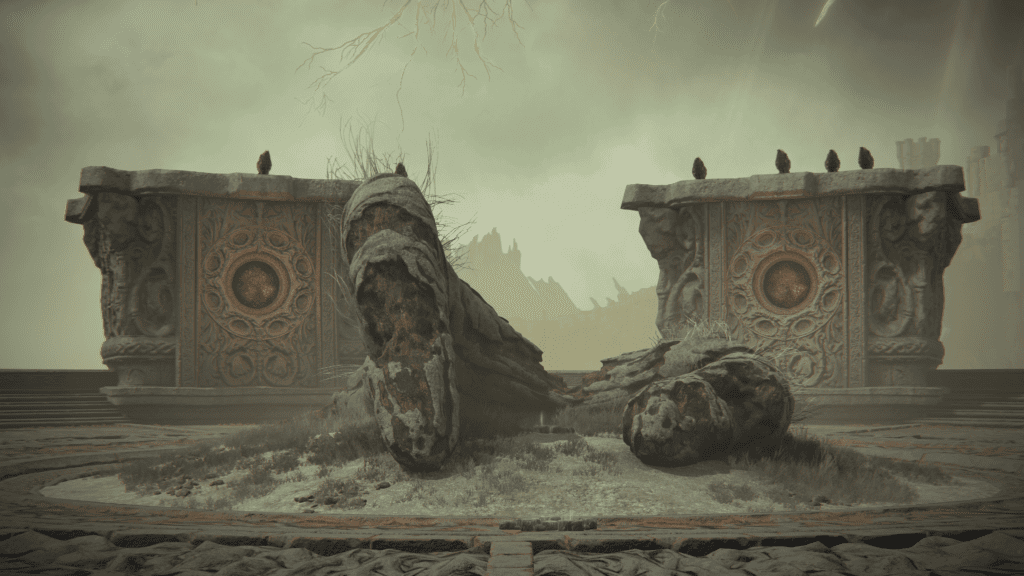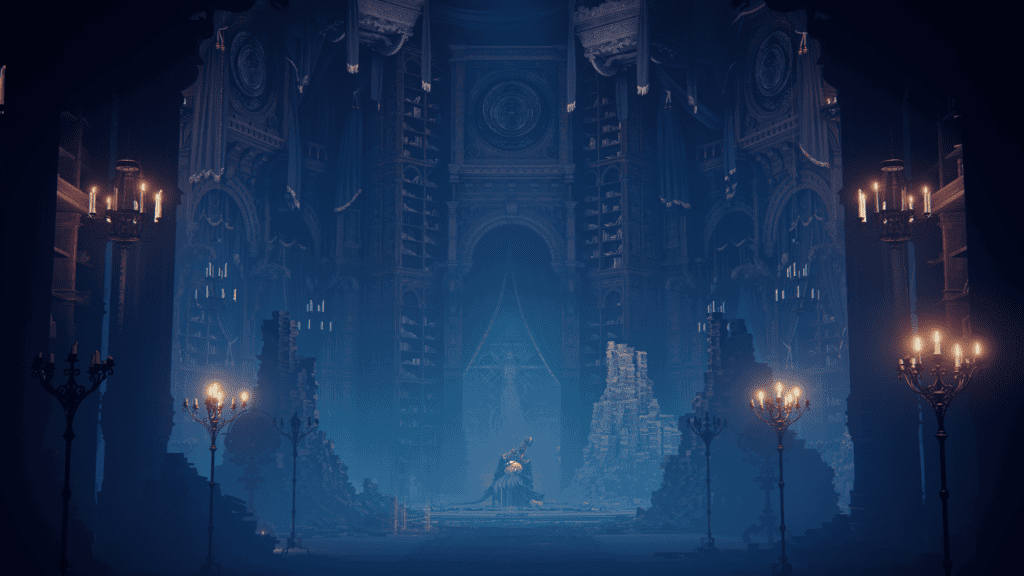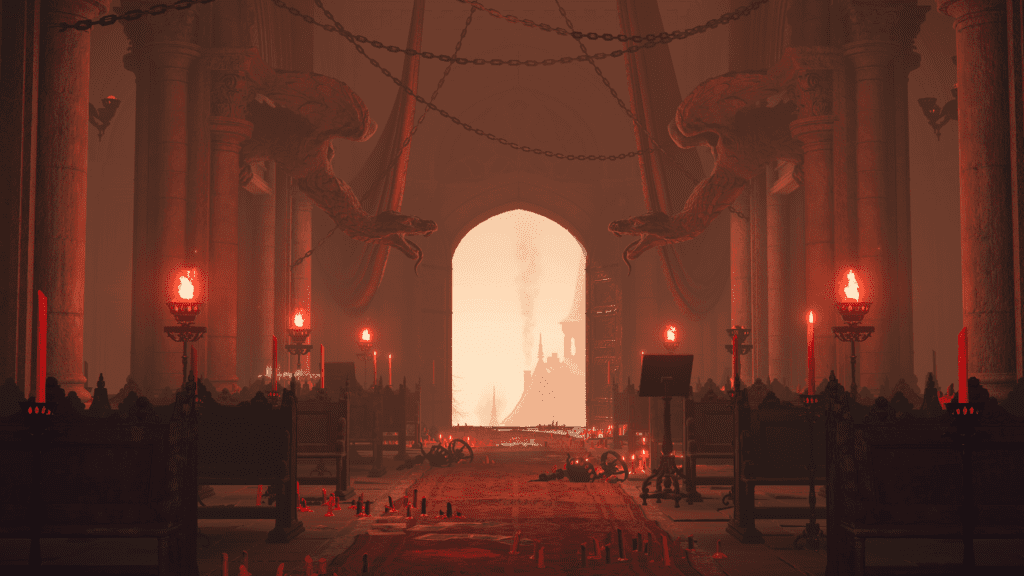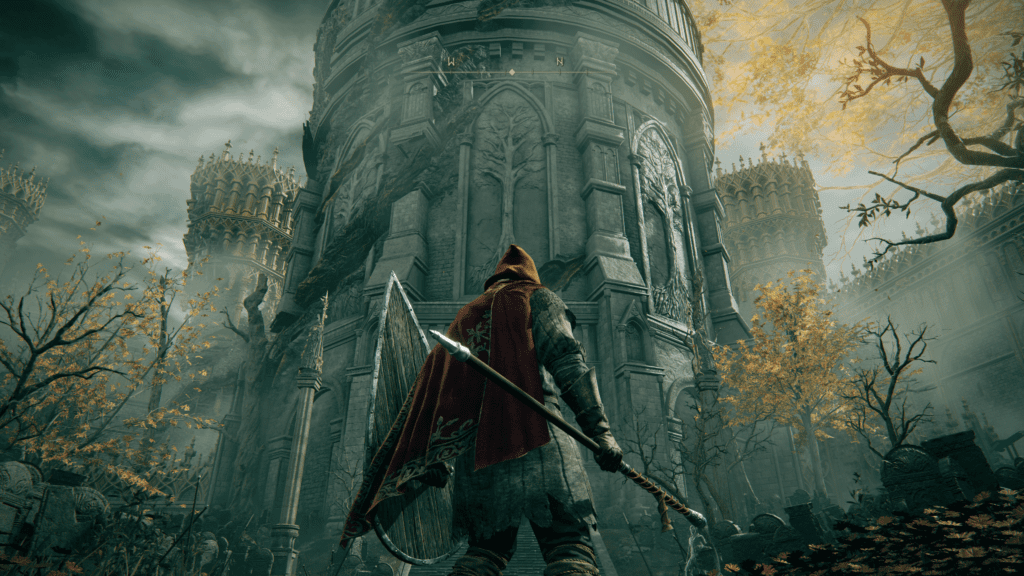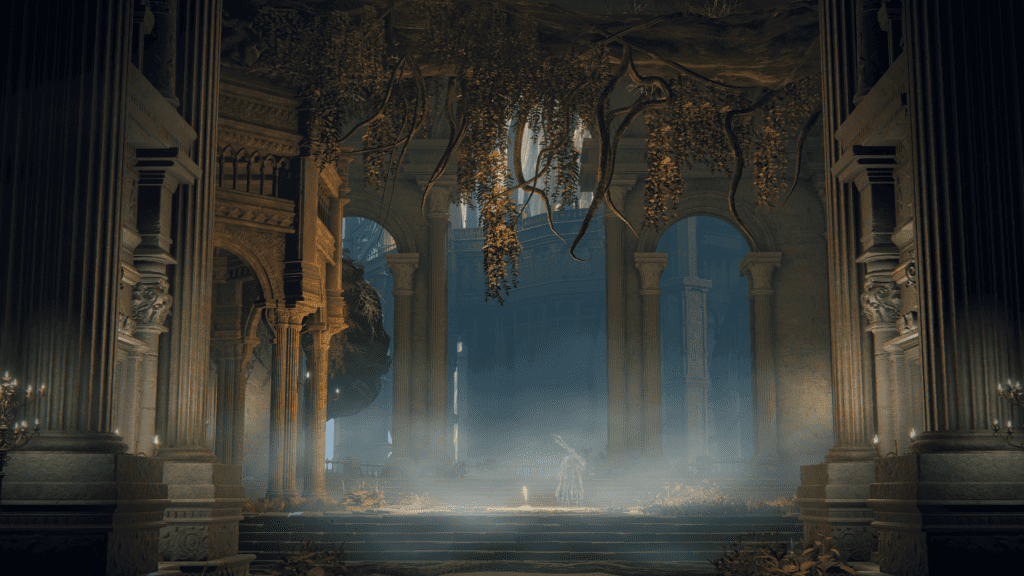I have always found myself on the outside looking in when it comes to Soulslike games. Their very nature is as intriguing as it is perplexing, not least due to the artful prowess with which they encourage a raft of likeminded players to meet their end over and over again, all in search of the next lock or key. The same brazenly hostile environment that attracts such prospective champions is exactly what has succeeded in keeping me away for the most part. Games that are part of the Souls collective, as disparate as they each can be, all share the same stubbornly uncompromising ethos that demands a certain level of commitment to the challenge ahead. And such a challenge invokes only the toughest of mettle, with success just as dependant on patience as much as it is skilfulness.
That’s not to say i’ve managed to completely avoid all exposure to games born of the Souls mantra. Many of the titles that fall into this emergent subgenre have certainly appealed to me in terms of character building, world design and the sheer novelty of completely unaided discovery. Though only one of their ilk, Bandai Namco title Code Vein, offered enough leniency when it came to cooperative play in order to help me surmount the required barrier of entry. By design, Souls games lack the kind of surety you can expect to find in plenty of other modern titles, and they revel in the unparalleled challenge that dictates their approachability. The discourse that orbits them frequently calls into question whether or not making the games more accessible would come at the cost of compromising their inherent ideals. Elden Ring offers no more assurances concerning its difficulty and mechanics than past iterations, but its pivot to an open-world structure is proof positive that the Souls formula is at least able to grow without losing a shred of its identity. This is a vast, engrossing colossus of a game, and amidst its renewal into something both pleasingly familiar and spectacularly different is just enough leeway for those uncultured in the world of Souls to find a foothold.
Your journey begins with a brief set of notes on how to handle your weapon before you push open a set of iron doors and emerge into the world ahead. The Lands Between stretch endlessly in every direction: the fingers of jagged clifftops claw at the sky, forgotten castles sit idle behind the veil of rolling mists, and luminescent great oaks rain golden leaves upon the scarred earth below. A collaborative effort between A Song of Ice and Fire author George R.R. Martin and the seasoned FromSoftware team of Souls mastermind Hidetaka Miyazaki, Elden Ring’s fantasy aesthetic is a feast for the eyes that evokes just as much wistful melancholy as it does palpable pangs of fear. As was to be expected from a Miyazaki game, unravelling the mysteries of certain locations largely depends on the player’s desire to pursue them, but a lack of context rarely gets in the way of appreciating the richness of the game’s stylisation. While Elden Ring may not be the prettiest game of its scale, its visual shortcomings, such as frequent graphical pop-in and aliasing, are alleviated somewhat by its stellar art direction. There’s plenty of beauty to be found in the ornate detailing of the towering stone marvels that dot the landscape, and plenty more in the seasonal colour palettes that bathe the world’s every imperfection in delicate hues of blue and gold. The expert application of lighting in particular works in tandem wonderfully with the gradual unveiling of new landmarks. At a distance, stone castles glisten beneath fleeting rays of sunlight, while undisturbed marshes shimmer against the reflection of the moon. And in a closer proximity, dimly lit caves cast a foreboding presence with their darkened passageways, flickering torch sconces and the glints of ever-watchful eyes.
THERE’S NO QUEST LOG TELLING YOU WHAT TO DO & NO MINI-MAP TELLING YOU WHERE TO GO. YOUR ADVENTURE IS COMPLETELY OF YOUR OWN MAKING
Elden Ring’s fantasy motifs are born from an amalgamation of inspirations that impart an enormous amount of character upon its expansive environment. Despite the almost daunting size of the world, there’s a tremendous amount of originality to be found across its diverse set of regions and a marvellously realised sense of harmony between them. Yet even the most unblemished of domains can only do so much to subdue the pervading sense of horror that stalks the land. The blissful meadows and rolling hillsides of starter zone Limgrave are a welcoming deceit that mask all manner of bloody rebellions and devilish rituals. While the burning rubble and heavy air of Caelid reckons with an entirely different kind of peril altogether. No matter where in the world that you find yourself, every corner of The Lands Between is either malformed or completely broken, ridden with its own set of ills. That moniker speaks to change, with the surrounding landscape feeling as though it’s teetering on the edge of an even darker abyss, simply biding its time before being completely swallowed whole. Elden Ring’s environment is a wonderful testament to fantasy horror, with FromSoftware expertly bringing it to life through a deeply refined understanding of their own unique approach to visual storytelling. And the emotive strength exemplified by its aesthetic design is perhaps only second to the enchanting rhythms evoked by its orchestral score. Though it may be a common occurrence to not hear a single world of spoken dialogue across hours of untethered exploration, it’s the soundtrack that compels you to continue onward, wordlessly guiding you through every clash of swords and moment of discovery. Often, the swell of a perfectly timed chorus is just the kind of motivation you need to push yourself through your next challenge, imbuing you with the confidence to vanquish the foe in front of you at the thirtieth attempt. Other times, it’s exactly what’s required to halt your crusade in its tracks, asking that you take a step back to bask in the diminutive echoes that bring to life the newest landmark rolling into view on the horizon.
Across its blighted fields, ashen hollows, murky dungeons and bubbling swamps, traversing the world of Elden Ring presents a challenge all its own. In fact, few areas of the map seem explicitly designed to actually inhabit players, such is the game’s subversion of your average open-world environment. As the landscape around you twists and gnarls with the fractures of an unfathomably destructive tectonic collision, FromSoftware have ensured that the world they’ve created, like the bosses that await you, cannot simply be bypassed. This is a land that demands you conquer it, with the uniquely challenging traversal of the map keenly ingrained into the very core of the experience. Despite it’s overawing size, there are plenty of areas within the open-world portion of the Lands in Between that operate in a traditionally Soulslike manner, pushing you towards your destination through a combination of linear passes and converging pathways. The environmental pathing of the open world isn’t exactly subtle, but it is successful at juggling the two often disparate notions of untethered exploration and necessary guidance alongside one another. Though the content of Elden Ring can be tackled in many different orders, it isn’t necessarily meant to be. Many areas in the game gate themselves off through enemy difficulty, quickly affirming that there’s yet more to see and do elsewhere before moving on to newer pastures permanently. This isn’t a problem so as long as you’re willing to explore the breadth of the game’s content, but it does unmask the nuance of any attempts at deliberate pathing, regularly forcing you to continue your journey by pivoting in an entirely different direction. The area of Caelid for example borders the starting location Limgrave, but it wasn’t until clearing two more later regions that I was strong enough to return to it. And even then, the northern reaches of the area were still too tough for me until I began my descent into the latter portion of the story. Such level spikes are frequent enough annoyances that progression across the map often begins to feel fractured. Elden Ring is certainly better without the inclusion of gamified, level-based zones, but the lack of consistency in certain pockets of the map comes across a little too sporadic and, at times, even makes things feel a quite unfair.
Whether on foot or at the reins of your spectral steed Torrent, you will be spending many of your hours in the game finding the lay of the land, which is why the time spent in that transitional period between two key locations is so valuable. The importance of occupying the player’s attention meaningfully as they move across such a large area is a task that Elden Ring overcomes through a calculated application of open-world sculpting. There is no filler here, no ancient ruin or deep delve that isn’t worth venturing in to. Though its game space may be packed with content, everything is given an equal weight of significance, which works to prevent gameplay from ever slipping into a rhythm of meagre box-checking. The unspoken imperative here is that, in order to ensure you’re within the right level range for the next major encounter, it’s important to see and do as much as you can. Not every dungeon along the way from Limgrave to the grand city of Leyndell will differ all too much from the last, yet the challenges that await within are not without their inherent value. By the time that you’ve exhausted your first region of all of its plunder, you’ll likely be sick of the sight of Spirit Ashes being dropped by bosses and Rune Arcs filling every expectant treasure chest. There simply aren’t enough unique rewards in the game for every named location to house something of relative worth. This isn’t a problem unique to this game either, with plenty of other open-world titles suffering from the same consequences of having so many of these smaller, more focused parcels of content scattered across such a large expanse. The prospect of acquiring a game-changing weapon is plenty enough of an incentive to dive into a hidden tomb on a whim, but where Elden Ring almost transcends that intrinsic need for the material is in its combat, which is without a doubt the most rewarding aspect of the entire experience.
Combining a deeply layered character building system with the learned skills of finesse, evasion and anticipation, combat, and in particular, combat performed against boss enemies, is the centrepiece of Elden Ring. At a glance, being faced with a foe that’s four times your size and capable of moving twice as fast may seem a little excessive. However much Elden Ring has remade itself in order to stand apart from the likes of Dark Souls and Bloodborne, the undeniable truth central to every fight is as it always has been: that victory and death remain an equal distance apart. A large part of the game is understanding that death is an asset to be used for your benefit, not necessarily a punishment for failure. Through death, you can ascertain the depth of an enemy’s move-set, the reach of their moves and the combinations that reveal when a specific attack is heading your way. The other half of the puzzle is in weaving your offence in between the brief windows of opportunity you’re given, and doing so in a way that makes your initial attempts look like they were separated by hundreds of hours of experience.
Elden Ring, just like its Soulslike predecessors, empowers players by presenting them with a challenge that seems insurmountable at first, then encouraging them to adapt their approach accordingly. But rather than strong-arming players towards a single, decisive way of fighting, the tougher the opponents become, the more adept you become with your chosen class. It’s not just the expectation of experience points and loot that galvanises your progression in Elden Ring—demanding battles frequently push you to the brink of your capabilities, before an unexpectant victory tears down those reservations and imbues you with the confidence to ask for more. And by the time that your desire for duels against demons and demi-gods alike compels you to visit all four corners of the Lands Between, you will have long-since been fully ingratiated in the ordered chaos that makes the game’s combat so special. Though it may lean heavily on subjecting players old and new to a particularly familiar trial by fire, Elden Ring reiterates once more that there’s an art to imparting knowledge through raw attrition, and that FromSoftware remain the undisputed masters of the craft.
It’s easy to think of Soulslike combat as being little more than the jousting between the player and a boss-level enemy within a fixed arena. As an open-world title, FromSoftware have had to think about a much more all encompassing style of threat, one that doesn’t just lurk behind the golden fog of boss doors, but also stakes a claim to their own territory out in the tundra of the Lands Between. Within the confined space of your typical boss fight, there’s little to separate you from your foe as the two of you duel to the death. Battles that take place within confined arenas are the purest expression of the ferocity that catalyses combat in Elden Ring. As an aggressive enemy ceaselessly claws at you, the only way to escape with your life is to meet their confrontation head-on and beat them at their own game. Outside of the confines of dungeons, caves and mausoleums, the rules are a little more flexible. You can flee if you so choose. And you can summon ashen spirits to lend you a helping hand. Best of all, you can call upon the aid of the environment in a way that isn’t usually possible when barred indoors. The natural contours of the land can make for just the right amount of cover in a pinch, protecting you from an attack that otherwise might’ve finished you off. Climbing up structures like cobblestone ruins and winding tree branches meanwhile can give you just enough elevation to fire a barrage of attacks without fear of being interrupted. Add to this the fact that you can mount your steed Torrent at any point during an open-world fight to flank an enemy or push beyond their range, and there’s plenty of opportunities for you to better pivot the odds in your favour. But no matter where in the world that you’re fighting, the majority of the game’s boss encounters all retain the same intrinsic sense of perilousness and theatricality. Elden Ring is filled to the brim with bosses to test yourself against, with the total number coming in at little over 200. However many of these you choose to seek out, rarely does the teeth-gnashing, adrenaline-fuelled spectacle fail to capture your attention. From a technical perspective, pinpoint hit-detection and fluid animations can make even the meekest of foes pose a genuine threat. Though there’s no disputing the aura of unmatched power that clings to the game’s apex predators, with each of the dozen or so major boss fights steeped in the kind of reverence that will keep them occupying your thoughts long after the credits have rolled.
With only the simplest of text descriptions on hand to aid you in decrypting the character menu, understanding exactly what attribute to improve and weapon talent to prioritise isn’t at all straightforward. Even after 75 hours with the game, I was still lost as to exactly what affinity counteracts which stat, as well as the direction I should be taking my build if I wanted to utilise its full potential. This isn’t the only area of the game in which Elden Ring requires a certain level of prior knowledge. Its complexities, like learning how to overcome a particularly devastating boss attack, or identifying the mechanic of a specific dungeon, are the kind of neat little puzzle boxes woven into gameplay that are challenging to manage but a lot of fun to solve. Other aspects of the game, like the summoning system and co-op limitations, seem more deliberately obfuscated, and not really handled with the same wisened approach to building within a space that’s so multifaceted and enormous. There’s a friction to Elden Ring that stems its sudden growth, where smaller components of the game become a little bit too archaic as it imparts itself upon a more modernised game space. Ultimately, Elden Ring does succeed at evolving itself without undoing its own core identity, though not without suffering through small fits of intermittent self-doubt.
At the very least, earning exactly what you need to level-up your character is easy enough and you’ll start doing so from the moment that you pick up your first sword. Whenever you kill an enemy, they drop runes, which is your currency for acquiring stat points, strengthening your weapons and purchasing things from vendors. Once you reach your next rune threshold and are able to level up, you’re encouraged to do so before disaster has a chance to strike. Die with runes in your pocket and they’ll be dropped on the floor. Die again before being able to pick them up and they’re gone for good. When you’ve made it back to the Roundtable Hold safe zone with thousands upon thousands of runes to spend, then comes time to decide which fire needs putting out first. No matter how many victories you claim, Elden Ring’s oppressive, escalating level of difficulty constantly pushes back at you, compelling you to continually invest in your character or risk having your progression halted. If you decide to level up your character, then there are 8 core attributes for you to choose from that each alter the way in which you interact with combat. The vigour stat gives you more health, mind increases your mana or ‘FP’, dexterity increases your rate of spell-casting and endurance raises your stamina. Character builds can be built around as few as two of these stats and serve as a functional, malleable way from which to approach the challenges that the game presents. As a mage, the backbone of my build centred around combining the increased mana of the mind stat with the damage given to spells through the intelligence stat. But it was only after understanding my weaknesses in combat that I realised it would probably be a sensible decision to put a few extra points into vigour and dexterity. Although the structure of your build is largely binding, you are able to start from scratch at least a few times per play-through providing you collect all of the ingredients for a special elixir. The biggest limiting factor comes in the form of weapon and spell choice, with certain swords and sorceries dependant on having a stat pushed to a specific level. Fittingly though, it’s your choice of weapon that really gives a build its flair, elevating mundane cloys for raw power into something much more stylish and unique.
THERE ARE PLENTY OF FIGHTS AHEAD OF YOU IN ALL CORNERS OF THE LANDS BETWEEN. ELDEN RING IS EVERY PART THE PUNISHING SOULS EXPERIENCE YOU REMEMBER
If you’re set on picking up a new weapon or even improving one that you’re currently fond of, then you won’t be left wanting for choice. Not content with limiting each armament to just a single, linear upgrade path, Elden Ring introduces ‘ashes’ to the Souls sphere, modifiers that apply special skills called ‘arts’ to weapons as well as altering them so that they work in harmony with a chosen stat. Providing that you’ve collected enough of them on your travels, there are plenty of ashes to choose from and little downside to trying them all out. Of course, having a dagger that suddenly morphs into a giant magical greatsword five times its size doesn’t really need to be anything else than just plain fun. But more than that, weapon ashes fit neatly into the Elden Ring survival kit and offer excellent utility without ever feeling dramatically overpowered. As with everything else in the game, there’s a learning curve to reckon with before you can consider calling yourself a master. Success is often dependant upon deploying an art at exactly the right time, though that’s not to say that their position in your build needs to be strictly as a fallback manoeuvre—as long as you’ve got the FP to cast it, there’s nothing stopping you from flourishing your art until every last enemy is reduced to mist on the wind. The process of refining your build and expressing yourself through your own particular style of combat is an aspect of Elden Ring that’s bettered by few other games. Added up together, weapon arts, attribute selection, weapon choice and the physick elixir work to mould your style of offence into something unique to your own experience. There are no rules denoting that a mage can’t backup their staff with a set of dual scimitars. And there’s nothing preventing a strength-adept warrior from shedding plate armour for silken robes. Breaking down the structure of a rigid class-based approach allows you to adapt to the challenge of Elden Ring fluidly. And though your attribute points may delineate a certain preference for swords, sorceries or wanton slashing, the space to impose yourself is wonderfully broad and largely unrestrictive.
Elden Ring’s transition to the open-world hasn’t been without its teething problems though, with perhaps the best evidence for this being in how the game handles cooperative play and PvP invasions. Summoning another player to aid you is a simple enough process: both players reach the same location in their separate worlds, before the summon puts down their unique sign and the host casts their summoning powder in the general vicinity. After playing through much of the game cooperatively, it rarely, if ever, went that smoothly. Almost every other time we tried to call upon one another, either one player would need to throw more of the summoning powder into the air, or another player would need to move their sign onto a completely different surface in order for it to appear. Inviting a third player into the group only posed more problems. Frame-rate drops, which were already rife, became even more common. And to add to that, disconnections occurred much more frequently, while the game repeatedly struggled to render the world for the summons, leading to them clipping through the floor and falling to their deaths. The unwritten rule of cooperative play in Elden Ring is that in order to keep co-op as a viable option, you need to avoid killing all of a certain subset of bosses within a single region. Inevitably, this is a consequence of enclosed areas requiring a transition through a fog door, which is necessary for threading together so many unique and detailed locations. The moment that you’ve put to sword all of the required bosses and open-world bosses in one region, the entire area then becomes a complete dead-zone for summoning. Other than deliberately leaving an open-world boss alive to serve as an anchor point, the only way around this would be to completely reset the area by progressing into your second run via new-game plus. It’s similarly disappointing that co-op play and PvP are so intertwined. At any time during co-op play, you’re liable to be invaded by another player whose sole purpose is prevent you from progressing any further. As both a summoner and a co-op partner, i’ve been invaded by players during climactic boss fights, in the middle of perilous dungeon puzzle sections and even minutes after ending a co-op session. Invasions regularly devolve into frustrating slogs against players stacked with meta weapons and high-end stats, and without the choice of opting out, what initially seems like a fun distraction quickly becomes tiresome. On the whole, cooperative play in Elden Ring is a boon, especially for players like myself who value any and all help that they can get. Frustratingly, the complications that arise from it are just a little too persistent to ignore, with the system seemingly given very little attention comparative to many other of the game’s open-world elements.
After initially being held back by pandemic-induced delays, Elden Ring shared its eventual release window with another open-world title in the form of PlayStation exclusive Horizon: Forbidden West. Inevitably, the two have drawn plenty of comparisons with one another, yet their mutual occupancy of the genre isn’t necessarily enough to put the two in parallel. Forbidden West inhabits the same oversaturated space as storied series’ like Assassin’s Creed and Far Cry. Unlike these series’ and many more that share the same make-up, Forbidden West improves upon enough of their stubborn formalities that it’s able to stand out even if it abides by many of the same rules. And that’s something that it most definitely does share in common with Elden Ring. Although FromSoftware’s open-world debut may inhabit a similarly structured game-space with plenty of familiar trappings, it’s still proudly adorned in an unquestionably Souls lustre. The result is an experience that differentiates itself by delivering a widely recognisable style of gameplay in a completely new, unique and engaging fashion. Elden Ring, like Breath of the Wild before it, has reiterated that the open-world canvas is capable of imparting experiences that aren’t just different thematically, but also mechanically. While many of the games encapsulated within the genre operate with more conventional ideals, Elden Ring’s path has been largely of its own making, with its multifaceted accomplishments perhaps best attributed to a team able to combine their breadth of existing knowledge with an entirely fresh perspective on the open-world space.
